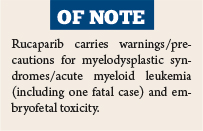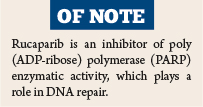In the Clinic provides overviews of novel oncology agents, addressing indications, mechanisms, administration recommendations, safety profiles, and other essential information needed for the appropriate clinical use of these drugs.
On December 19, 2016, rucaparib (Rubraca) was granted accelerated approval for the treatment of patients with deleterious BRCA mutation–associated (germline or somatic) advanced ovarian cancer who have received two or more prior chemotherapy regimens.1,2 The U.S. Food and Drug Administration (FDA) concomitantly approved the FoundationFocus CDxBRCA test, the first FDA-approved next-generation sequencing–based companion diagnostic to identify patients with advanced ovarian cancer eligible for treatment with rucaparib. The test detects alterations in BRCA1 and BRCA2 genes in ovarian cancer tumor tissue.
Supporting Efficacy Data
Approval of rucaparib was based on objective response rate among 106 patients with advanced ovarian cancer in 2 single-arm open-label trials. Patients received oral rucaparib at 600 mg twice daily. Patients had a median age of 59 years (range = 33–84 years), 78% were white, all had an Eastern Cooperative Oncology Group performance status of 0 or 1, all had received at least 2 platinum-based regimens, and 43% had received at least 3 prior lines of chemotherapy.

The investigator-assessed overall response rate was 54% (57 of 106 patients; 95% confidence interval [CI] = 44%–64%), with a complete response observed in 9%. Median duration of response was 9.2 months (95% CI = 6.6–11.6 months). The objective response rate was 66% (52 of 79 patients; 95% CI = 54%–76%) in platinum-sensitive patients, 25% (5 of 20 patients; 95% CI = 9%–49%) in platinum-resistant patients, and 0% (0 of 7 patients; 95% CI = 0%–41%) in platinum-refractory patients. The overall response rate was similar for patients with BRCA1 and BRCA2 mutations.
How It Works
Rucaparib is an inhibitor of poly (ADP-ribose) polymerase (PARP) enzymes, including PARP-1, PARP-2, and PARP-3, which play a role in DNA repair. Studies in vitro have shown that rucaparib-induced cytotoxicity may involve inhibition of PARP enzymatic activity and increased formation of PARP-DNA complexes, resulting in DNA damage, apoptosis, and cell death. Increased rucaparib-induced cytotoxicity was observed in tumor cell lines with deficiencies in BRCA1/2 and other DNA-repair genes. Rucaparib has been shown to decrease tumor growth in mouse xenograft models with or without BRCA deficiencies.
How It Is Used
The recommended dose of rucaparib is 600 mg twice daily with or without food, with treatment continued until disease progression or unacceptable toxicity.
Accelerated Approval of Rucaparib
- Rucaparib (Rubraca) was granted accelerated approval for the treatment of patients with deleterious BRCA mutation–associated (germline or somatic) advanced ovarian cancer who have received two or more prior chemotherapy regimens.
- The FDA concomitantly approved the FoundationFocus CDxBRCA test, the first FDA-approved next-generation sequencing–based companion diagnostic to identify patients with advanced ovarian cancer eligible for treatment with rucaparib.
- The recommended dose of rucaparib is 600 mg twice daily with or without food, with treatment continued until disease progression or unacceptable toxicity.
For management of adverse reactions, interruption of treatment or dose reduction should be considered. Recommended dose reductions are to 500 mg twice daily, 400 mg twice daily, and 300 mg twice daily for first, second, and third reductions, respectively.
Safety Profile
The safety of rucaparib has been evaluated in 377 patients with advanced ovarian cancer receiving 600 mg twice daily. The most common adverse events of any grade were nausea (77%), asthenia/fatigue (77%), vomiting (46%), anemia (44%), constipation (40%), dysgeusia (39%), decreased appetite (39%), diarrhea (34%), and abdominal pain (32%). The most common grade 3 or 4 adverse events were anemia (25%), asthenia/fatigue (11%), nausea (5%), and thrombocytopenia (5%). The most common laboratory abnormalities of any grade were increased creatinine (92%), increased alanine transaminase (ALT; 74%), and increased aspartate transaminase (73%); the most common grade 3 or 4 abnormalities were anemia (23%), increased ALT (13%), and neutropenia (10%).

Adverse reactions led to dose reduction or interruption in 62% of patients, most commonly due to anemia (27%) and asthenia/fatigue (22%) and to discontinuation of treatment in 10%, most commonly due to asthenia/fatigue (2%).
Myelodysplastic syndromes (MDS)/acute myeloid leukemia (AML) was reported in 2 of 377 patients (0.5%). AML was also reported in two patients (< 1%) with ovarian cancer, in a blinded randomized trial comparing rucaparib vs placebo.
Rucaparib carries warnings/precautions for MDS/AML (including one fatal case) and embryofetal toxicity. Patients should be monitored for hematologic toxicity at baseline and monthly thereafter, and use of rucaparib should be discontinued if MDS/AML is confirmed. Women should be advised not to breastfeed during treatment. ■
References
1. U.S. Food and Drug Administration: Rucaparib (Rubraca). Available at http://www.fda.gov/Drugs/InformationOnDrugs/ApprovedDrugs/ucm533891.htm. Accessed January 11, 2017.
2. Rubraca (rucaparib) tablets prescribing information. Clovis Oncology, December 2016. Available at http://clovisoncology.com/files/rubraca-prescribing-info.pdf. Accessed January 11, 2017.

